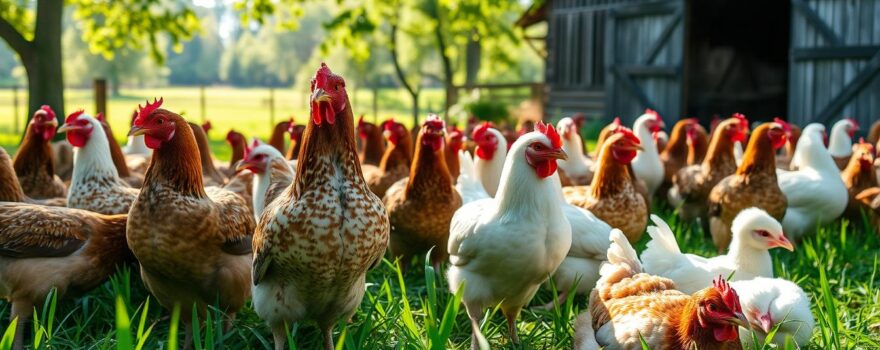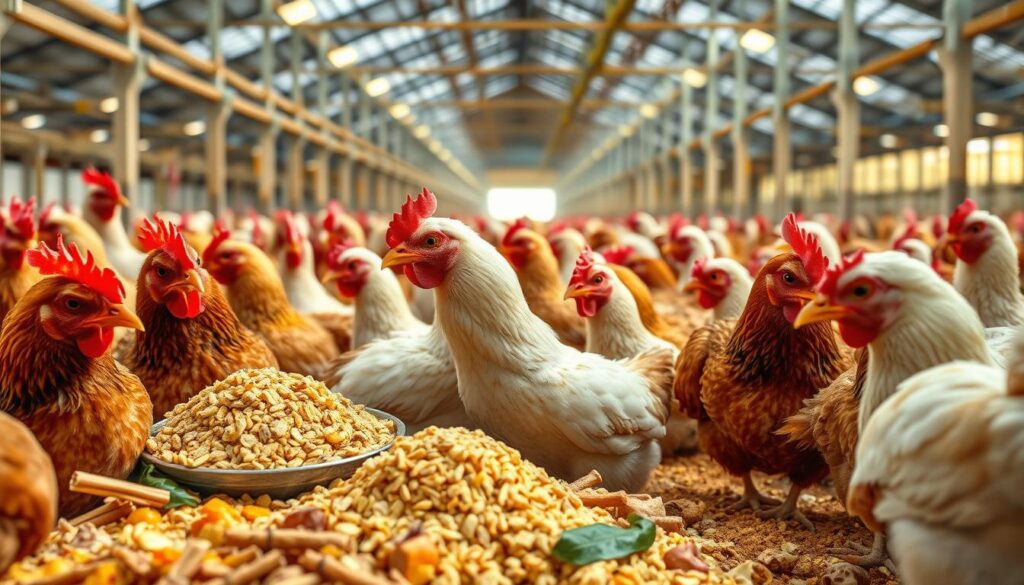
Broiler chickens are key in the poultry industry for meat. The finisher phase, from 37 days to slaughter, is vital. It helps broilers grow fast and efficiently, making high-quality meat.
This phase is crucial for better feed use, more meat, and better meat quality. It also uses special feed additives for growth. This ensures broilers reach their target weight quickly and healthily.
Key Takeaways
- The finisher phase is essential for optimizing feed conversion ratio in broiler chickens.
- Proper feed formulation during the finisher phase can enhance carcass yield and meat quality.
- Utilizing feed additives in the finisher phase can support overall growth performance of broiler chickens.
- Consistent feeding schedules and monitoring growth rate are crucial for maximizing broiler chicken growth during the finisher phase.
- The finisher phase plays a vital role in the overall broiler chicken lifecycle, contributing to efficient and healthy meat production.
Understanding the Broiler Chicken Lifecycle
The broiler chicken lifecycle has three main stages: starter, grower, and finisher. Each stage is vital for the birds’ growth and development.
Starter Phase
The starter phase lasts from day one to about 17 days. During this time, the birds need a special diet. This diet is rich in high-quality protein to help them grow muscles fast.
Grower Phase
The grower phase goes from about 17 to 37 days. It helps the chickens grow and develop muscles more. This phase gets them ready for the final stage, where they will reach their full size and weight.
The broiler chicken industry is growing fast. It’s expected to increase by 16% by 2025. Countries like Argentina, Brazil, and the United States will lead in production. In Asia, China, India, and Thailand will be the top producers.
| Age (Days) | Feed Consumption (Gallons/1,000 Birds) | Feed Consumption (Gallons/1,000 Birds) |
|---|---|---|
| 7 | 6.3 | 10.5 |
| 21 | 26.2 | 50.0 |
| 42 | 62.9 | 131.0 |
| 63 | 78.6 | 157.0 |
As the broiler chicken industry grows, knowing the lifecycle is key. It helps in optimizing production and meeting the demand for poultry meat.
The Importance of the Finisher Phase in Broiler Chicken Growth
The finisher phase is key in broiler chicken growth, happening after 37 days until slaughter. It’s when the feed is made to help broilers grow fast and efficiently. This results in high-quality meat.
This phase is great for feed efficiency. Birds on phase-feeding diets grow faster and eat more. They also gain weight better with less amino acids than those on NRC diets.
The finisher phase also boosts carcass yield and meat quality. While there’s no big difference in carcass yield or fat, the diets support growth and yield as well as NRC diets.
Using feed additives like phytase enzymes in the finisher phase helps too. Studies show phytase improves growth, nutrient digestion, and bone health. This is especially true when the diet lacks nitrogen, calcium, and phosphorus.
“The finisher phase is essential for optimizing feed conversion ratio, enhancing carcass yield and meat quality, and utilizing feed additives to support overall growth performance.”
In summary, the finisher phase is vital in broiler chicken production. It affects feed efficiency, carcass yield, meat quality, and how well feed additives work. It’s all about better growth.
Nutrient Requirements During the Finisher Phase
Broiler feed in the finisher phase is made to give a balanced diet. It helps chickens grow fast and have good meat quality. The feed has lots of protein, energy sources, and vitamins and minerals for health.
Protein and Amino Acids
Protein is key for broiler chickens’ muscle growth. Finisher diets have 19-21% crude protein. They focus on amino acids like lysine and methionine.
Research shows that chickens can grow well on different proteins. This includes corn gluten meal, sunflower meal, and distillers dried grains with solubles.
Energy Sources
Broiler finisher feeds balance carbs and fats for energy. Grains are the main energy source. Fats add to the diet’s energy and help with vitamin absorption.
The calorie-to-protein ratio is about 160 kcal per gram of protein. This is important for the birds’ energy needs.
Vitamins and Minerals
Broiler finisher feeds have essential vitamins and minerals. These include vitamins A, D, E, and B-complex vitamins. Minerals like calcium, phosphorus, manganese, and zinc are also added.
Keeping the right balance of these nutrients is key. It helps with growth, bone health, and immune function.

Feed Formulation for Finisher Broilers
Creating a good finisher feed is key for broiler producers to make more money. They use a least-cost feed approach. This makes the feed support growth performance, feed efficiency, and better carcass yield and meat quality.
The protein in broiler finisher feed is between 14% and 16%. This is because broilers need less protein as they get closer to market weight. The feed has the right mix of amino acids for muscle growth and protein making. It also has energy sources like grains and fats/oils for body functions and growth.
Pelleted feeds are often used because they cut down on waste and boost feed efficiency. The feed might also have additives like enzymes and antioxidants. These help with digestion, gut health, and keeping the feed fresh.
It’s important to feed broilers regularly and keep an eye on their nutrition. This ensures they get the nutrients they need for growth and finishing. By doing this, producers can help their birds grow fast, improve meat quality, save money, and lower death rates.
“Using top-notch broiler feed solutions, like Champrix Broiler Concentrates or Premixes, makes feeding easier. It also makes sure birds get the right nutrients for the best growth and meat quality.”
Feeding Management Practices
Effective broiler feeding management is key to better growth and feed use. Keeping a steady feeding schedule and clean water always available is crucial. Also, watching how fast broilers grow helps in success.
Consistent Feeding Schedule
Having a set feeding schedule is vital for broiler health. Broilers do best with a routine that includes regular, high-quality feed. This ensures they get the nutrients they need, helping them grow well.
Monitoring Growth Rate
Keeping an eye on broiler growth is important. Regular weighing helps spot any growth issues. This info lets producers adjust feed to help broilers reach their full growth.
Digital tools like the 123POULTRY app help with this. They give insights for better feeding decisions.
| Feeding Phase | Protein Content | Energy Sources | Feeding Duration |
|---|---|---|---|
| Prestarter | 18-24% | High-energy grains | 0-7 days |
| Grower | 19-22% | Balanced energy sources | 17-37 days |
| Finisher | 16-20% | High-energy grains | 37 days to slaughter |
By following these feeding practices, producers can improve feed use and growth. This leads to better productivity and profits in broiler farming.
Optimizing Feed Conversion Ratio
In the broiler industry, the feed conversion ratio (FCR) is key to making money. By making broiler chickens use feed more efficiently, farmers can boost their profits. There are several ways to improve FCR during the broiler’s growth phase.
Precise Feed Formulation
Creating the right feed is crucial for broiler chickens to use nutrients well. Feeds should match the birds’ needs at each stage of growth. The right mix of proteins, energy, vitamins, and minerals can help improve FCR.
Consistent Feeding Management
Keeping a steady feeding schedule and providing enough space are vital. Also, clean, fresh water is essential. These practices help broilers grow steadily and reduce waste, improving FCR.
Utilization of Feed Additives
Feed additives like enzymes, probiotics, and antioxidants can boost broiler feed conversion ratio and feed efficiency. They help digest nutrients better, keep the gut healthy, and fight off stress. This leads to better growth performance.
| Treatment | Feed Conversion Ratio | Final Body Weight (g) |
|---|---|---|
| 0g BEP | 1.62 | 2,189 |
| 150g BEP (0.05mm sieve) | 1.58 | 2,245 |
| 300g BEP (0.05mm sieve) | 1.55 | 2,301 |
By using these strategies, farmers can better the broiler feed conversion ratio. This leads to higher feed efficiency and growth performance. It makes their operations more profitable.

“Optimizing the feed conversion ratio is a critical factor in achieving sustainable and profitable broiler production.”
Impact on Carcass Yield and Meat Quality
The finisher phase is key in broiler chicken production. It affects carcass yield and meat quality. Good nutrition and feed management during this phase improve meat tenderness, flavor, and taste.
Recent studies highlight the importance of feed and feeding practices. For example, a study with 120 Hubbard broiler chicks showed a diet with low-metabolizable energy and enzymes improved carcass traits and organ weights.
| Parameter | Control Diet | Low-ME Diet | Low-ME Diet with Enzyme |
|---|---|---|---|
| Liver Weight | – | – | Increased (P = 0.038) |
| Bursa Weight | – | Highest (P = 0.043) | – |
| Thymus Weight | – | Highest (P = 0.019) | – |
| Myofibril Fragmentation Index | Highest | – | Lowest (P = 0.043) |
| Shear Force | – | – | Highest (P = 0.022) |
| Breast Meat Yellowness | – | Lowest (P = 0.019) | – |
| Breast Meat pH | Highest (P = 0.001) | – | – |
The study also found that enzymes in the low-ME diet improved nutrient breakdown. This allowed for less energy in the diet. These results show that careful feed formulation and enzymes can improve broiler meat quality.
Feed additives like phytogenic feed additives (PFAs) and probiotics, such as Bacillus licheniformis, also enhance meat quality. They improve nutrient use, reduce oxidative stress, and boost the immune system in broiler chickens.
In conclusion, the finisher phase is crucial for improving broiler carcass yield and meat quality. By focusing on feed composition, feeding management, and using feed additives, producers can ensure high-quality meat. This meets the changing demands of the market.
Role of Feed Additives in the Finisher Phase
As broiler chickens get closer to the finisher phase, using feed additives is key. These supplements, like enzymes and probiotics, help with growth and health. They make nutrients easier to digest and boost the immune system.
Enzymes help break down proteins, carbs, and fats better. This means broilers grow faster and use feed more efficiently. Probiotics, meanwhile, keep the gut healthy. This reduces sickness and keeps the intestines strong.
Some additives also have anti-inflammatory and antioxidant effects. These benefits improve immune function and overall health. This leads to better meat quality and higher yields, benefiting everyone involved.
A study on a complex phytobiotic feed additive showed its benefits. It included tannins, calcium butyrate, and other ingredients. These helped the birds grow faster and more efficiently.
“The strategic use of feed additives in the finisher phase can be a game-changer, helping broiler producers optimize growth, feed efficiency, and overall bird health during this crucial stage of the production cycle.”
The demand for poultry meat keeps growing. So, the importance of feed additives in the finisher phase is more critical than ever. By using these supplements, producers can make broiler production more efficient and sustainable.
The finisher phase is key in broiler chicken growth. It affects feed efficiency, carcass yield, and meat quality. By fine-tuning feed, feeding, and using additives, farmers can see better growth and profits.
Research shows the finisher phase is vital for better chicken growth and feed use. Changing the diet’s nutrient levels and the phase timing can greatly improve efficiency. Feed additives also boost meat quality and bird performance.
Optimizing the finisher phase helps farmers save money and grow their profits. Even small changes can make a big difference in the poultry industry’s efficiency and success. A detailed approach to the finisher phase is crucial for top chicken growth, yield, and quality.